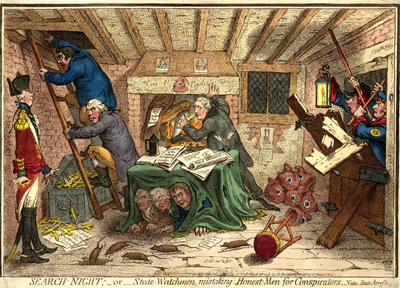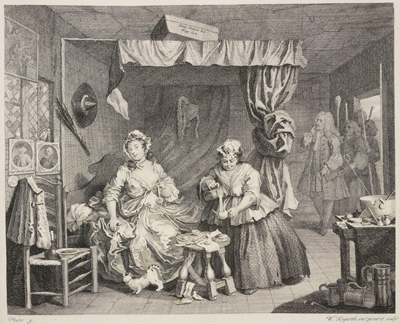Search Night. . .
This wonderfully composed and highly allusive print shows seven of the most prominent Whigs in a narrow, rundown room surprised in their supposedly treasonous plots against the country by the "State Watchmen" (Prime Minister William Pitt, and Secretary of State for the Home Department Henry Dundas). And like the rats in the foreground, they now appear to be seeking the nearest hiding place to escape detection and arrest.

© Trustees of the British Museum
The "Conspirators" include the Whig leader Charles James Fox and his frequent ally, Richard Brinsley Sheridan, now climbing the ladder to the roof, the Dukes of Bedford and Norfolk going up the chimney, and the Whig politicians Horne Tooke, John Nicholls, and George Tierney cowering beneath the table. As the bolted door is smashed in by Pitt and Dundas, all but Lord Moira, standing apart and across the room, present their backs to the guard, looking behind them guiltily.
The prevailing sense of the print, however, is one of fear, and of things closing in. This is created by the subject matter, of course, as Pitt and Dundas break their way into the room, but also by the raftered ceiling whose beams point inward, and by the close perspective on the action; the print itself is bounded by the walls, floor, and ceiling of one room.
In this Gillray may have remembered (and been inspired by) Hogarth's Harlot's Progress Plate Three which also features a shabby room whose dimensions define the boundaries of the print and where (stage right) the arresting authorites with staves have just entered.

© Royal Collection Trust
Like Hogarth's, the meaning of Gillray's scene is "explained" by a host of small but significant details. Since 1791, Gillray had been associating prominent Whigs Like Fox and Sheridan with French revolutionaries. In The Impeachment (1791), for instance, he portrayed William Burke denouncing them as "the abettors of Revolutions" and "the authors of Plots & conspiracies." In The Dagger Scene (1792) he had Burke accusing them of being part of a conspiracy to manufacture 3000 daggers and hire 19 assassins, "for where French principles are introduced, you must prepare your hearts for French Daggers." So it is not suprising to find Fox and Sheridan climbing the ladder next to a box overflowing with French daggers.
Gillray had also been routinely portraying French sympathizers, like the Whigs, with bonnets rouges made to resemble fools' caps. So it is also not surprising to see bonnets rouge in the corner of the room (one for each conspirator). And it is certainly no accident that the most prominent bonnet rouge/fools cap appears over the fireplace with the revolutionary slogan, "Vive l'Egalite" where the two Lords are making a hot retreat. For if a revolution delivered a truly egalitarian society, the two nobles, Norfolk and Bedford, would be the ones most likely to be "burned" for their foolishness or to suffer the fate of Robespierre at the guillotine.
The impetus for Search Night was perhaps most closely bound up with the "Irish Question." The Irish-born Earl of Moira (far left) had been warning for more than a year that repressive measures taken by the English and Irish parliaments against the citizens of Ireland in the name of maintaining order would likely lead to rebellion not stability. Significantly, then, at his feet is a copy of The Press, the newspaper of the United Irishmen (edited by Arthur O'Connor) with "Bloody News from Ireland." Another paper, however, just below it suggests the ministerial reaction to Irish complaints which was to discount them as tall tales, like those of "Munchausen,"
But in late February, scarcely a month before Search Night appeared, the Irishman, Arthur O'Connor, John Binns, deputy of the London Corresponding Society, and two other members of the United Irishmen had been arrested as they were on their way to France to coordinate an uprising in Ireland with another French invasion. The papers on and below the table including a "Plan of Invasion" showing France and Ireland, a letter signed "O'Conner" a "Plan for raising United Irishmen," and the "Proceedings of the London Corresponding Society" all are intended to suggest that the seven prominent Whigs were part of the plot.
Gillray had been given a pension from the Pitt government in November 1797 to produce prints favorable to the ministry, and in many ways this print certainly qualifies. At a time when another French invasion was a national obsession and the fear of internal plots was becoming more and more justified, Search Night portrayed the Whigs in the worst possible way. But Gillray's use of irony never makes things simple. He could have, for instance, confirmed the substance of the print in its title by saying something like "Search Night: Catching Conspirators in the Act." And he could have left the surely loyal and trusted Moira out of the print entirely, but instead Gillray gives the print an ironic title that nonetheless raises the possibility of error and gives convincing expression to the fear created by repressive measures backed by the suspension of habeas corpus: Search Night; or State Watchmen mistaking Honest Men for Conspirators.
Sources and Reading
- Commentary from the British Museum on Search Night.
- Christiane Banerji and Diana Donald, Gillray Observed, 1999, Ch. 2.
- Draper Hill, Fashionable Contrasts, 1966, #33
- "Francis Russell, 5th Duke of Bedford," Wikipedia
- "Henry Dundas, 1st Viscount Melville," Wikipedia
- "Charles James Fox," Wikipedia
- "Francis Rawdon-Hastings, 1st Marquess of Hastings," Wikipedia
- "Charles Howard, 11th Duke of Norfolk," Wikipedia
- "Baron Munchausen," Wikipedia
- "John Nicholls," History of Parliament
- "William Pitt the Younger" Wikipedia
- "Richard Brinsley Sheridan," Wikipedia
- "George Tierney," Wikipedia
- "John Horne Tooke," Wikipedia
- "London Corresponding Society," Wikipedia
- "Society of United Irishmen," Wikipedia
- Thomas Wright and R.H. Evans, Historical and Descriptive Account of the Caricatures of James Gillray #184.
- Thomas Wright and Joseph Grego, The Works of James Gillray, the Caricaturist; With the History of His Life and Times, p. 238.
Comments & Corrections
NOTE: Comments and/or corrections are always appreciated. To make that easier, I have included a form below that you can use. I promise never to share any of the info provided without your express permission.